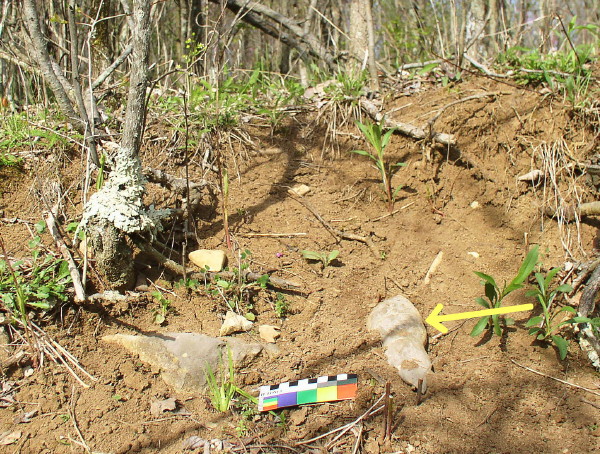| In April 2015 this
limestone artifact was discovered eroding from a bank at approximately
25 cm below the current terrain
surface (see in-situ photo below). |
|
|

|
Its front surface,
face down in the photo, is carved and ground into an unmistakable human female form, while the back remains mostly
unworked gray cortex. Note the clear morphological similarity of the figure to
the well known Neolithic and earlier "Venus" figures (unfortunate terminology that we're
apparently stuck with), down to the breasts, defined pubic area, tapered (and laterally concave) base, and subparallel
incised striations along the sides.
It seems likely that the pointed/curved base facilitated mounting
the figure vertically into the ground.
Below, for
comparison of the striations, the well known mammoth ivory Venus of Hohle Fels from
near Schelklingen, Germany, from ca.
37,000 years BP:
The
Ohio Venus is clearly fashioned as a sharply pointed and bifacially edged blade
tool, although it does not appear to have actually been used as such.
The piece's overall form, in addition to being that of a shapely human female, presents an ergonomic blade-with-handle configuration, the blending of utility and
iconicity typical of the artifacts at this site.
As far as this author is aware, this is the first discovery in the western hemisphere of an ancient artifact in the classic
Upper Palaeolithic Venus form.
Of course it may or may not be of pre-Holocene manufacture, but if not, it almost certainly represents the migration of an old and well
established
mental template from Eurasia to North America.
| Above: Side view of
the lower part of the figure, showing a birdlike figure
characteristic of this site.
|
The photos below show some less spectacular yet quite interesting smaller limestone artifacts that appeared in
context with the "Venus". Note that the incised lines on the bird-form piece
are very much
like those on the Venus figure.
|